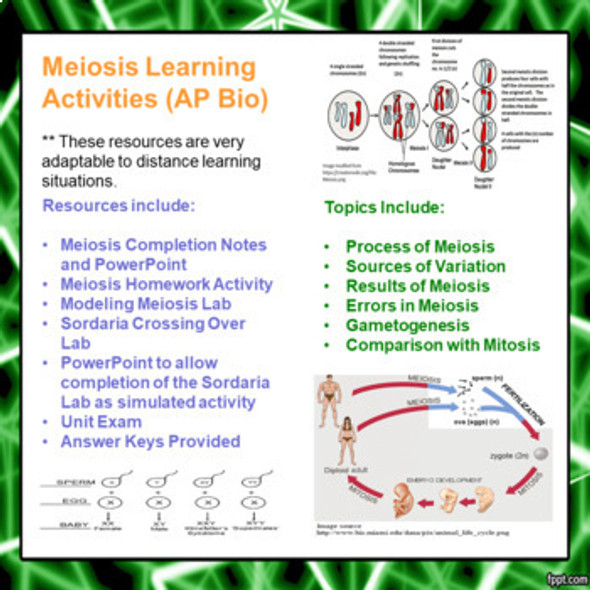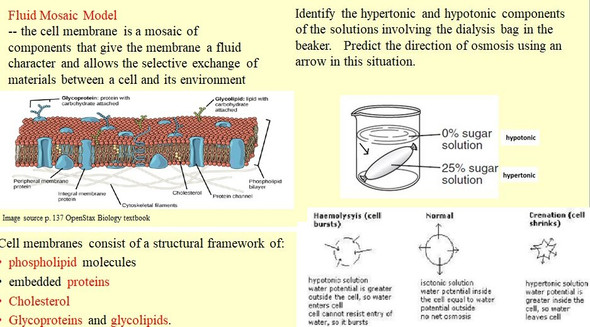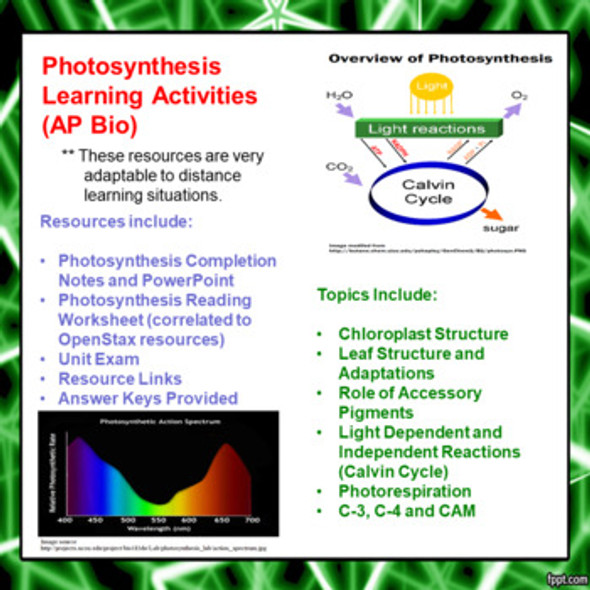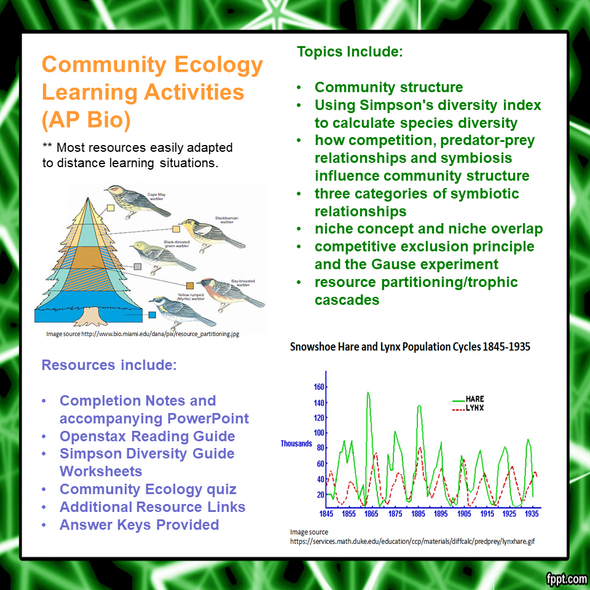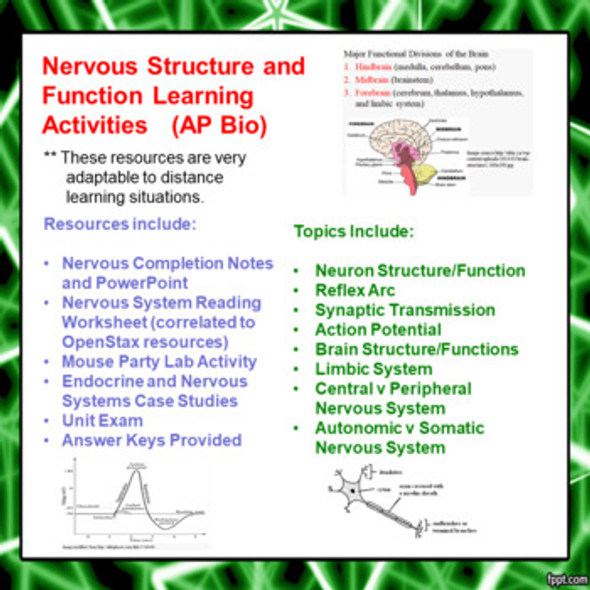Enzyme Learning Activities for AP Biology (Distance Learning)
- Bulk Pricing:
- Buy in bulk and save
- Contributor:
- Monday's Rescue
- Grade Level:
- 9-12
- Product Type:
- Learning Package (Notes, PowerPoint, Lab, Homework)
- File Type:
- doc, pdf, ppt
- Pages:
- 41
- Answer Key:
- Yes
Description
This zip file contains many different activities (41 pages of student handouts and 2 PowerPoints with a total of 94 slides) which can be used to compose a unit for AP Biology or advanced Biology students involving major topics concerning enzymes. Topics in this unit enzymes and reaction rate, enzyme structure, substrates, active sites, lock and key versus the induced fit enzyme model, factors including enzyme activity including pH, temperature, salts, competitive and noncompetive inhibitors, allosteric effects, zymogens and feedback inhibition.
This lesson packet contains a listing of the learning goals, common core learning standards, NGSS learning standards and the AP Biology performance indicators addressed in these materials. These are included in the packet and at the end of the description of this lesson.
Most documents are included in both word as well as pdf format to allow editing for specific teacher needs. These learning materials are well suited for a distance learning situation.
The learning guides/assignments contain links to online resources to support student learning. This product has been updated to the curriculum revisions for the 2019-2020 year in AP Biology.
Answer keys are included for all items including some suggested answers for the three lab activities (as the answers and data obtained by students can exhibit a good deal of variation).
All documents are included in word and pdf format The specific contents of the learning package includes the page count for the student documents as answer key page counts are not included. The specific contents listed below:
- Enzyme Learning Standards and Objectives (2 pages)
- Brief Review of Kinetics and Potential Energy Diagrams PowerPoint (28 slides)
- Completion Notes to accompany the Brief Review of Kinetics and Potential Energy Diagrams PowerPoint (3 pages)
- Enzyme PowerPoint (66 slides)
- Completion Notes to accompany the Enzyme PowerPoint (9 pages)
- Enzyme Exam with key (50 questions) (9 pages)
- Enzyme Worksheet # 1 with key (8 questions) (2 pages)
- Enzyme Worksheet # 2 with key (5 multi-part question with graph) (3 pages)
- Factors Influencing Reaction Rates Lab (6 pages)
- Enzyme Reaction Rate Lab with key (3 pages)
- Instructions and How to do video for the Enzyme Catalysis Reaction Rate Lab (2 pages)
- Paperase Lab with Key (4 pages)
Enzyme Learning Objectives ETS
Enduring Understanding
ENE-1 The highly complex organization of living systems requires constant input of energy and the exchange of macromolecules.
Learning Objectives
ENE 1.D Describe the properties of enzymes.
ENE 1.E Explain how enzymes affect the rate of biological reactions.
ENE-1.F Explain how changes to the structure of an enzyme may affect its function.
ENE-1.G Explain how the cellular environment affects enzyme activity.
Enzyme Student Learning Goals (local)
Upon the completion of this unit the student will be able to:
1. describe the influence of enzymes on chemical reactions and represent this influence on a potential energy diagram.
2. describe the basic structure of an enzyme.
3. define the terms substrate and active site.
4. describe the role of coenzymes and cofactors in relation to the structure and function of enzymes.
5. compare the lock and key and induced fit hypotheses of enzyme function.
6. discuss how and why changes in temperature, pH, and ion concentration influence enzyme activity.
7. define the term denaturization.
8. recognize the effects when a fixed amount of enzyme is placed with an excess of substrate and explain why these effects occur.
9. recognize the effects when a fixed amount of substrate is placed with an excess of enzyme and explain why these effects occur.
10. explain how enzyme activity can be regulated by competitive and noncompetitive inhibition.
11. define the term zymogen and discuss an example of this.
12. define the term allosteric interaction and explain how these can be used to regulate metabolic pathways.
NGSS Standard
HS-LS1-6. Construct and revise an explanation based on evidence for how carbon, hydrogen, and oxygen from sugar molecules may combine with other elements to form amino acids and/or other large carbon-based molecules.
Common Core State Standards Connections:
ELA/Literacy
RST.11-12.1 Cite specific textual evidence to support analysis of science and technical texts, attending to important distinctions the author makes and to any gaps or inconsistencies in the account.
WHST.9-12.2 Write informative/explanatory texts, including the narration of historical events, scientific procedures/ experiments, or technical processes.
WHST.9-12.5 Develop and strengthen writing as needed by planning, revising, editing, rewriting, or trying a new approach, focusing on addressing what is most significant for a specific purpose and audience.
WHST.9-12.9 Draw evidence from informational texts to support analysis, reflection, and research.
Mathematics
MP.4 Model with mathematics.
Terms of Use
Purchase of the product is for classroom use by the purchaser only. It is a violation for individuals, schools, and districts to redistribute, sell, or post this item on the Internet or to other individuals.
This work is licensed under a Creative Commons Attribution-NonCommercial-ShareAlike 4.0 International License.
This learning package bundle is part of the AP Biology Complete Course. The complete course contains 22 learning package bundles in addition to this one. Save nearly 60% over the cost of buying 23 individual unit learning bundles with your purchase of the complete course.





